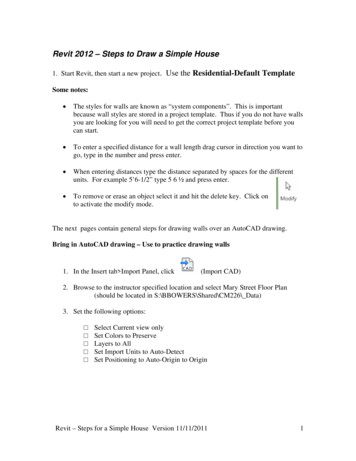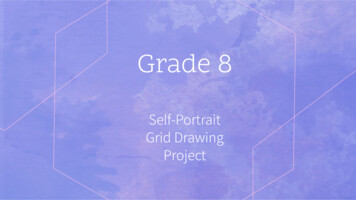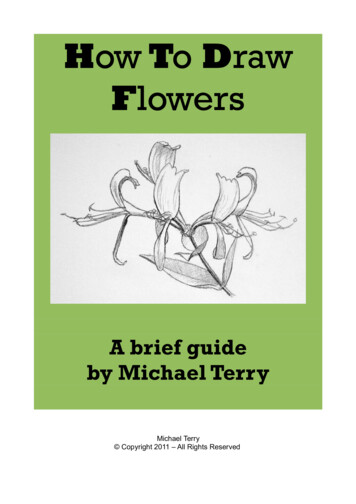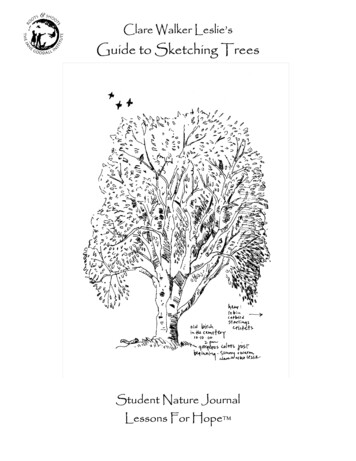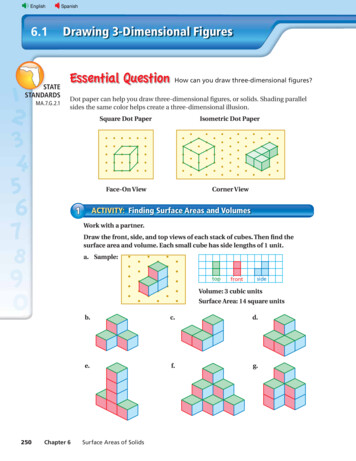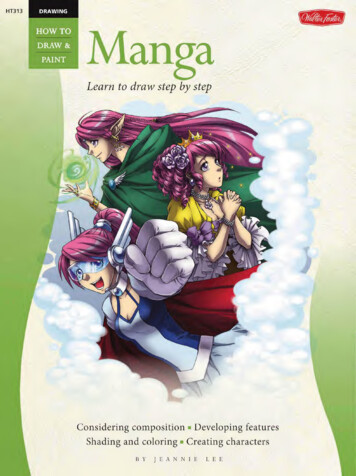
Transcription
HT313DRAWINGHOW TODRAW &PAINTMangaLearn to draw step by stepConsidering composition Developing featuresShading and coloring Creating charactersBYJEANNIELEE
www.walterfoster.comWalter Foster Publishing, Inc.3 Wrigley, Suite AIrvine, CA 92618 2010, 2011 Walter Foster Publishing, Inc.All rights reserved. Artwork 2009, 2010 Jeannie Lee.All rights reserved. Walter Foster is a registered trademark.This book has been published to aid the aspiring artist. Reproduction of the work for study or finishedart is permissible. Any art drawn or photomechanically reproduced from this publication for commercialpurposes is forbidden without written consent from the publisher, Walter Foster Publishing, Inc.Digital edition: 978-1-6105-9839-2Softcover edition: 978-1-6005-8193-9
Author Jeannie Lee always had an affinity for comics and cartoons—she grew up with Korean comics(man-hwa) as a child and was a devoted Disney fan. When she first discovered Japanese manga and anime,however, she knew she was hooked for life. Jeannie started drawing at a very young age, and her supportiveparents found a talented local contemporary Western artist by the name of Ji Young Oh, who took Jeannie underher wing for over seven years. Jeannie considers Ms. Oh to be the most important artistic influence in her life. Hereducation also included two years of studying traditional character animation at California Institute of the Arts;from this education spawned interests in Flash animation and working with vectors. Jeannie considers herself veryfortunate to be able to indulge in many types of artistic expression and plans to continuously increase her skillset in the years to come. Currently, Jeannie is a digital artist at Gaia Interactive, and she has worked for MarvelEntertainment, Inc., TOKYOPOP, and UDON Entertainment. When she isn’t working, she indulges in variouscrafts and hobbies, such as knitting.CONTENTSThe Art of Manga.2Different Body Types.14Materials.3Male Hero.16Basic Shapes.4School Girl.18Shading.5Ninja.20Composition.6Basic Manga Principles.22Drawing Heads.8Choose Your Own Adventure.24Drawing Hair.9Manga Meet & Greet.26Drawing Facial Features.10Finding Inspiration from Real Life28Full Figure Male.12Manga-fy This!.30Full Figure Female.13Conquer the Manga-Verse.32
MANGA BASICSThe Art of MangaManga is the Japanese word for "comics," which literally translates to"whimsical pictures." It is generally used to describe comics that are made inJapan, but it is also loosely used to describe comics that resemble Japanesecomics, even though they are not created in Japan. The four major types ofmanga are shonen, shojo, seinen, and josei. Shonen, or boys' manga, isaction-packed and usually includes sports, science fiction, or fantasyelements. Dealing with romance, comedy, and coming-of-age drama, shojomanga is aimed at junior high school and high school-aged girls. Adult maleaudiences read seinen manga, which offers business and crime stories, aswell as historical and military dramas. And for young and middle-agedwomen, josei manga focuses on career, family, and romantic dramas. Thereare also manga for food enthusiasts, gamers, and other hobbyists.Most manga is produced in Japan and translated for overseas audiences,but original manga and manga-influenced works can increasingly be found inKorea, China, France, and America as well. Discover the art of manga withthe instruction in this book,produce your own manga,and become a part of thegrowing global mangacommunity!TipIn Japan, a mangaka, or manga author, hasassistants who help with details, backgrounds,and screentone. Most manga artists start off asassistants before attaining full mangaka status,but it is possible to gain recognition throughcontests and skip the apprenticeship stage.You too can become a mangaka!
Lines of ActionDifferent types of lines in a composition, such as curves or diagonals, can convey action and movement. However, the line of action is a specific,imaginary line that extends through the main portion of the figure you are drawing, usually following the direction of the figure's spine. The line of action,along with two smaller lines—the shoulder line and the hip line—define a figure's pose. It is also helpful to plan out the facial feature guidelines on thehead and the four major joints in your initial sketch. These structures will allow you to quickly and efficiently establish a character's pose. A good exercisefor understanding how these interrelated lines and joints make up a pose is to observe a live, human figure—your own body! Strike several differentposes in front of a large mirror and sketch out the line of action, shoulder line, hip line, major joints, and facial guidelines.Line of Action The blue line of actionShoulder and Hip Lines The shoulder andTilting Lines Tilt the shoulder and hipabove mimics the spine and the tilt of theneck and head. Defining the line of actionfirst will help you figure out the rest of thepose, since all body parts follow theorientation of the trunk and spine.hip lines intersect the line of action anddefine the position and origin of movementfor the limbs. Establishing these lines withthe line of action offers base for how far thelimbs can move in any direction.lines in opposite directions to achieve moreinteresting and natural-looking poses. Doingso adds a subtle dynamic to the pose, whencompared to a character whose shouldersand hips are parallel to the ground.PerspectiveFront ViewThree-Quarter View InSide ViewFrom the front view, witha subject simply standingfacing forward, the hipand shoulder lines areparallel and the fourmajor joints are equal insize. In males, theshoulder line is generallylonger than the hip line,since males tend to havebroader shoulders thanfemales.this diagram, the figure isat a three-quarter angle,which is the mostcommonly drawnperspective. Notice thatthe shoulder and hipjoints (red circles) closestto the viewer are largerthan the joints on thefarther side. (See page 12for more on this effect.)The side view is oftendifficult to draw, becauseonly the line of action andjoints closest to theviewer are visible. Isuggest drawing throughthe image and placing alllines and joints. Yourfinaldrawing will appear morethree-dimensional if youcan visualize the entirestructure.
MANGA BASICSDrawing HeadsThe head is probably the most important body part todraw, as it is the source of a character's emotion andNaturalisticpersonality. Study the diagrams of the male and femaleheads at right for average ratios and proportions betweenfacial features. Some artists draw in a more realistic styleEye Linewith facial proportions that are closer to the real humanform; other artists choose to draw in a more stylized wayNose LineMouth Linewith bigger eyes or longer foreheads. Once you understandthe fundamental shapes and proportions of a typical realisticface and its features, you can bend the rules to create moreextreme or unique styles.StylizedT-Zone A simple yetefficient way of measuringeye distance is to use theeye itself. Generally, thespace between the eyes isabout the length of one eye.There is a similar amount ofspace between the bridgeand tip of the nose. However,these are only averagemeasurements—your stylemay dictate otherwise!Step 1Step 2Step 3Step 4Step 5To draw a head, begin withthe head shape, which isusually an oval. See "HeadShapes" on page 11 forOnce you have establishedthe face shape, sketch inthe guidelines forthe facialfeatures—a cross for theNext lightly sketch thebasic features—theeyes, ears, nose, mouth,eyebrows, and hairline.When you are satisfiedwith your sketch, ink yourdrawing, or turn it into lineart. Add the final details,examples of different headshapes.eye line and T-zone, andshorter horizontal linesforthe nose and mouthTry to sketch lightly, asdarker lines are difficult toerase and may wear downlocations.the paper if you decide toredraw any features.such as eyelashes andpupils. Some artists colordirectly on a refined sketch;others clean and tightenthem with line art first.The final step is coloring.Whatever medium youdecide to use here iscompletely up to you!See page 5 for coloringtechniques.
Drawing HairCurly, spiky, cropped, or straight—there aremany different ways to draw hair and hairdos canbe interpreted differently based on an artist'sstyle. Some artists prefer drawing hairrealistically with a lot of detail. Others prefer astylized look, and draw only contour lines thatimply the hair's shape. You can also block in thehair without highlights or shading if a characterhas dark hair. The choices are endless!Hairstyles and Personality Hair can play an important role in defining a character. Forexample, you may give a bubbly, shdjo girl bouncy curls or a young, rebellious hero pointy,gravity-defying locks. Accentuate a tough guy's angular features with close-cropped hair, awidow's peak, and sideburns.Hair texturesIt is helpful to understand how individualstrands and clumps of hair behave whentrying to depict various hairtextures andstyles. Natural hair styles will have adifferent shape and weight than crimped,curled, or bluntly cut hair.Hair and Gravity In this illustration, the hair is transparent, so you can see how hair drapesaround the head and neck. Keep in mind that gravity determines how a character's hair falls.Decide where you want to part the hair (this example shows a side part) and draw the hairhanging down from that part.Manipulated Hair Imagine each strand ofhair as a string. When straight, it is at itsmaximum length. Adding a wave, crimp, orcurl shrinks the strand. Now rememberthathair is made up of many individual strands.Hair and Head Shape There is a close relationship between the skull, head, and hair. TheHair Ends In most styles, hair ends areshape of the skull defines the head shape and the head shape affects the size and direction ofhair growth. Some characters have large hair styles or tie their hair back, and wind mayinfluence the shape of hair. Always draw hair around the shape of the head and consider theeffects of gravity.drawn in points or clumps (above, left). Youalso can draw hair that is cropped straight atthe ends, giving the hair a freshly cutappearance (above, right).
DrawingFacial FeaturesA great deal of manga storytelling occurs on a character's face where a range of emotions are displayed. On page 8 you learned the basic proportionsand relationships between features. Now let's focus on the individual facial features and see how they all work together to bring a character to life.Noses and MouthsEyesEyes are easily the most expressive part of a character's face, and thereNoses don't move the way mouths and eyes do, but they complete theare an infinite number of ways to draw them. Above are a couple of basicoverall symmetry of the face and add a bit of character. Some artists find itexamples of different eye shapes and sizes. Notice how the eyes draw yourdifficult to draw noses, especially from the front view, but sometimes it justattention and define the character. The male with beady, narrow eyes couldtakes two small dots, short lines, or the implied shadow of the nose. Alsobe a villain, and the big, bubbly eyes on the right could belong to a youngkeep in mind that males tend to have more prominent noses. The mouth isboy in a shojo comic. Try experimenting with a few different eye styleswhat makes a character smile, frown, laugh, or shout. Like eyes and noses,while thinking about the type of character you are trying to portray. Factorsthere are many ways to draw mouths—with simple lines or defined lipssuch as age, ethnicity, and personality can all affect the eyes.and dimples. On the other hand, some artists don't draw noses at all. Thisis especially common in chibi drawings, where the nose plays a lesser role.EyebrowsEyebrows are also important for portraying expressions. Since eyebrows are made of hair, they will usually be the same color and style as a character'shair, although you can choose to give a little man huge, bushy, black eyebrows. Altering the shape of the eyebrow is effective for showing emotions. Forexample, if both eyebrows are facing sharply towards the center of the face, that would make the character look very angry. Having them point up maygive the feeling of surprise or shock. You can use your own face as a reference—get in front of a mirror and start making faces, and pay attention to howyour eyebrows move and shift with each one.Angled EyebrowBushy EyebrowArched EyebrowThin, Rounded EyebrowRealistic Eyebrow
Drawing Expressions Now put all of the facial features together tocreate different expressions. The character at left is shown making avariety of extreme faces—happiness, sadness, embarrassment,disapproval, outrage, fear, and wickedness. Even though the expressionschange, the character should remain clearly recognizable in all drawingswith consistent features, or readers may confuse him/her for differentcharacters. A great exercise is to draw one character with many differentemotions, making sure that he/she looks like the same characterthroughout.TipThe best way to practice expressions is toobserve and draw from real life. If you havea friend who also likes to draw, one of youcan make faces at the other while youquickly sketch them. You can also look toyour favorite manga artists to see how theyapproach different emotions andexpressions.Head ShapesThe shape of a character's head can reveal a lot aboutthe character's personality. While the most common head shape is an oval, there are many otherpossibilities. The three basic shapes for drawing anything are the circle, square, and triangle. Experiment by combining the different shapes to create moreunique and expressive head shapes.Dval Most of your characterswill have oval-shaped heads.Triangular Sharply angledSquare Give strong, beefy guysCircular Comical charactersheads are good for evil villains.sturdy, square heads.often have circular heads.
MANGA BASICSFull Figure MaleUnderstanding the human form is integral to becoming a manga artist, as human bodies are featured prominently in this character-driven art form.Below is a brief overview of a standard male form. While there are many types of male bodies—thin, overweight, or bulky—I generally like to drawrelatively fit males with broad shoulders and slim waists. I also use angular lines, sharp muscle definition, and geometric shapes to convey strength andfirmness. The guidelines below show how to use a character's head as a measuring unit. A standard figure's height is equal to seven of its heads. Theseproportions apply to the four major full-figure views—front, three-quarter, side, and back. Another general observation is that the male's upper body tendsto be broader and wider than the lower body.Foreshortened MaleWhen viewed from above,this male figure is fore shortened. The top of thehead and shoulders arelarge, with the rest ofthe body drawn withincreasingly shorter linesto convey depth anddistance.Sitting Male While you candraw the body in an infiniteamount of poses, the actuallength and size of any givenbody part never changes. Thisis where basic shapes andlines of action help guide youthrough complex proportionsand poses.
Full Figure FemaleFor my particular style, I like to draw females with trim, firm, and fit bodies—not too thin or voluptuous. Flowever, a character's figure also depends onher age; for example, adult women tend to have more prominent curves than teenage girls. While males are usually heavier in the upper body, femaleshave smoother, rounder contours—particularly in areas such as the chest and hips. Therefore, females generally carry more weight in their lower bodies.The female's height is also equivalent to seven of her heads. Flowever, if you put the male and female figures side by side, the male is taller, because thefemale's head is smaller, resulting in an overall shorter height.Lounging Female In this pose,Foreshortened Female As with the male figureviewed from above, this female's lower bodyappears smaller and farther away.the female's heads and hands areclosest to the viewer. Her lowerbody is smaller, as it's fartheraway, or foreshortened. She isalso lying at an angle, whichhelps further define theforeshortening.
Different Body TypesOnce you are comfortable using the basic rules of body proportions andforeshortening discussed on pages 12-13, you can draw any adult or youngadult body type and pose. You can even choose to exaggerate bodies ortweak specific body parts (see page 15).You may also want to create younger and older characters or charactersthat grow up during the course of your story. To depict characters ofdifferent ages, fundamental laws of proportion still apply. However, thereare some important differences between the bodies of children and adults.Below is a character at different ages, from a baby to an adult woman.Notice how her head is much larger in proportion to her body as a childthan as a teen and adult. Also notice that as she ages, her curves, as wellas her muscles, become more defined. Males tend to develop muscles andbroader shoulders as they age, also.At this stage, male andfemale babies often looksimilar, especially if youdisregard characteristics thatdefine gender, such asclothes. At birth, babies'heads are much larger inproportion to their bodies.Exaggerating this concept bymaking the head and eyesvery large and the hands andfeet very small helpsemphasize the young age.Young children tend to havebaby fat, resulting in evenlyshaped, rounded torsos, andcarry a lot of baby fat andlimbs without muchdefinition. Take away thingslike clothes and hair, andgender can still be hard todistinguish. Like withbabies, drawing larger eyesand bigger heads will conveya more childlike age.In adolescence, fatdisperses, and musclesand bone structure becomemore prominent. A teenagegirl, for example, may havelonger legs and a curvybody, but still maintain aslim waist and form, whichcan help define her youth.Eye size can shrink, whichcan help define aging andgrowing up.As a fully grown adult, thischaracter's bone structure,muscles, and "hourglass"shape are well-defined. Shestands at her full seven-headheight.
What's a Chibi?A common drawing concept found in anime and manga is the "chibi" form.Chibis are generallysmaller, simpler caricatures of characters that are used to illustrate light, comedic situations.The word "chibi" is Japanese for "short person" or "small child." However, that doesn't make achibi. The three figures below are c/7/7?/versions of the characterson page 9. They are portrayed in a simplified and light-hearted fashion. What makes them chibiyounger version of a character aratherthan children is thatthey appear olderthan children, but are drawn in a cute, cartoon-likestyle. Any character can be drawn inchibi style—even the most menacing villains!Elongated Chibi Not every chibi character hasto be short and stout. You can create a variationof the chibi form by drawing big heads with thin,elongated bodies. The most prominent feature ofa chibi is the disproportionately large head andeyes, as well as simplified facial features. Studyyour favorite manga to see how chibis are dealtwith and be sure draw in a style that creates amood appropriate to a comic chibi situation.Exaggeration Now that you've learnedthe fundamentals of drawing bodies, youcan experiment and learn how to bendthe rules. Many manga artists employexaggeration to achieve stronger, moreprominent characteristics. One of themale figures at left is extremely muscularwith heavily exaggerated facial features.The other character is a heavyweightsumo wrestler. If you removed allthe muscle and fat from these twocharacters, their bodies would be similarin terms of bone structure. However, themuscular character is composed ofmostly angular lines, and the sumowrestler is round virtually all over. Theirbodies and facial features make a boldstatement about their personalities.
MANGA BASICSMale HeroMost manga adventures feature a mysterious and moody hero with a serious but honorable goal or quest. This male hero may appear cold and distant,but he embodies the values of perseverance, fellowship, and justice.\r"\Step 1Step 2Sketch the body with basicSketch the basic contoursshapes and map out the lineof the body and sword.of action, hip and shoulderDeveloping the body will helplines, and major joints. Finalizewith clothing shapes and foldsthe pose, body proportions,later. Working from the headforeshortening, and perspectivedown, add basic details in theat this stage to preventhair, face, hands, and feet.troublesome revisions later on.TVStep 3Step 4Now add the clothes, but sketchOnce you have your final sketch,lightly, as hard lines are difficultyou can ink your drawing toto erase and tend to smudge.create line art or make in moreWork in layers, drawing thepermanent. Inking will forceshirt, coat, and pants. Next addyou to clean up your drawing,accessories, such as the tie,making it easierto scan or colorpocket chain, and shoes.over.
FinishingTechniquesFine details and value contrasts canbring a characterto life. Not all ofthe details have to be drawn in theline art; shapes, depth, and detailscan be rendered with coloring. Seepage 5 for more information oninking, shading, and coloring.Details In the line art, the majordetails have been drawn in, butthe nose is only represented withnostrils.Step 5Once you've finished the line art,begin coloring the male hero. Keepyour light source in mind. Layingdown colors in layers helps (seepage 5). Use grays and black fortheLayers Color in layers, startingwith the lightest colors andgradually building up darkercolors.sword, jacket, pants, and shoes. Colorthe face, neck, and hands with fleshtones. Finally, add touches of blue forthe eyes, gold in the sword, and redfor the tasseled cord and necktie. Ifyou prefer, make several photocopiesof your line art, or scan and printseveral copies, if you want to practicewith different styles and materials.Shadows and HighlightsCreate sharper contrasts bydarkening shadows andbrightening highlights.
MANGA BASICSSchool GirlShQjo manga often revolve around the daily lives of junior high or high school students. This school girl's main concerns involve passing her classes,finding romance, and bonding with her girlfriends. She may have hidden super powers, but that's for you, the mangaka, to decide!Step 1Step 2First, sketch out the basicDraw the basic contours of theshapes forthis casual pose.body, hair, and handbag. Next,Be sure to establish the action,add her facial features. Thinkshoulder, and hip lines, placeabout the character's person the major joints, and measureality. This classic girl next doorout accurate body proportions.has straight hair and wide,innocent eyes.Step 3Step 4Now draw her clothing. AInk the sketch and erasetraditional Japanese schoolunnecessary marks. Use fine,uniform includes a collaredthin lines for a light, cheerfulshirt, tie, sweater, and shortmood. You may want to makepleated skirt. To complete thecopies of your inked drawing tooutfit, add accessories, suchpractice coloring on and workas hairpins, a watch, plushout your color palette beforekeychain, and shoes. Be sureapplying colorto your line art.to render yourfinal details andtextures at this stage.
ExpressiveLike hair, facial features, and bodytype, accessories tell a story as well.The school girl's bookbag, plushbunny, and hair clips show heryouthful innocence. Below, see howjewelry, weapons, and otheraccessories add character.Pet Lover This young girl's collarand bell strongly identify her withthe animals that she adores.Bad Boy Something as tinyas an earring can give thisconfident bad boy a bit ofunconventional charm.Step 5Begin coloring by laying down thelightest colors first, and then buildup the darkest areas. If you areworking with markers, use lightpressure. Try using a cool gray forthe sweater and a warmer grayor brown for the bag. With softstrokes, capture the textures inthe blue skirt and strands of brownhair. Colorthe tie red and add pinkforthe hair pins, watchband, andshoes. Finish up by adding a fewkey highlights with a white gel penor white acrylic paint. Adding whiteFighter A deadly ninjadots to the eyes and jewelry makestar, sleek sword, or classic pistolreflects a character's fightingstyle.them look brighter and shinier.
MANGA BASICSNinjaNow that we've covered everyday characters, such as the school girl and the male hero, you may want to try out something more dynamic and complex.A ninja is a great character to experiment with, as ninjas are expert assassins and have extremely agile movements and action-packed lives.Step 2Begin with the basic shapes and lines of action. Forthis ninja, it maySketch the contours of the body, and add the facial features. I drew in thebe harderto see the line of action and joints because of the extremeentire face here so the expression would be clearly defined. Shape outpose. Keep in mind that arms and legs don't shrink in length thoughthe muscles, fingers, and legs. With an action pose, you want to reviewforeshortening (see page 12-13) makes it look like they do. Experiment atyour sketch often to see if it looks awkward or if the pose looks too stiff.this stage to find a really dynamic pose.You can always ask a friend to pose for you or keep a mirror handy.Step 4Draw the basic clothing and accessories, including weapons, sandals,Now ink yourfinal drawing, sharpening up the details. As this imageand spiked gauntlets. Carefully render the different folds and textures.involves many distinct elements that are close together, be cautious aboutAlthough his face will be covered, I suggest sketching the ninja's facialsmudging. You can place a small ruler or plastic lid beneath your hand tofeatures to establish his personality and expression.prevent the oils on your skin from smearing your work.
Step 5The color palette for a ninja is basically monochromatic. His clothing,sword, eyebrows, and mask are very dark gray and black. Colorthe bandaround his leg a dark brown and let the lighterflesh tones of his fingersand area around his eyes provide a dramatic contrast to his dark apparel.Next, add silver accents to his armor, spikes, headband, andshuriken, orthrowing star. Complete the image with piercing blue eyes, and rememberto leave bright highlights in the eyes and reflective metal items.
YOUR MANGA WORLDManga Meet & GreetThe types of characters that populate the manga world are vast and varied, rangingfrom magical girls who lead secret lives to sinister villains who constantly challengeour courageous heroes. Knowing the genre of manga that appeals to you—heroic,romantic, hobbyist, or eclectic—can help narrow down your character options. Firstdecide on your protagonist, and then think about his/her relationships with the othercharacters in your story.A compelling story follows a protagonist through a journey of discovery andpersonal progress, whether the protagonist is a hero on an epic quest or an ordinarystudent dealing with daily life. Each character in the story contributes to theprotagonist's development and may act as an ally, rival, love interest, or enemy. Youmay also choose to focus on more than one protagonist or add characters for the solepurpose of comic relief. Regardless of your character choices, be sure to portray themin situations that bring out their most prominent personality traits, involve a lot ofinteraction, and allow them to affect each other's character growth.Chibis Draw chibiversions ofyour characters for comedicscenes or make all of yourcharacters adorable chibis!Animals Include cute mascots,animal familiars, or giant talkingcreatures in your story. You can alsocenter the drama on the bondbetween a character and his/her pet.Cat Girl Are you a feline lover?Add the purr-feet touch to yourmanga with a cat girl, a commoncharacter whose origins can betraced back to the transformingcat of Japanese folklore.
Heroes and Villains Popularheroes and villains include ninjas,vampires, and knights. Pit yourcharacters against each otherfor action-packed drama!Magical GirlFascinated by theidea of secretidentities? Featurea high school girlwho transforms intoa magical heroine!comedies pair up attractivemaids with ordinary guys.Add a twist to this conventionwith a bookish or clumsy maid.Dtaku An otaku is a fan ofanything, from video gamesto manga. Use an otakucharacter to show how anaverage, geeky guy canwin romance andrecognition with hiskind heart.
YOUR MANGA WORLDFinding Inspirationfrom Real LifeMost artists draw upon their own experiences and feelings to find inspirationfor their art. Try creating a love story that is based upon your own romanticexperiences or a fantastical story that brings your most serious or silliest hopesto life. You can also manga-fy a friend's eventful life.Another great way to come up with storylines and characters is to look aroundyou for inspiration. Ordinary people that you see and come into contact with dailycan spur intriguing characters. Take time to simply observe people and imaginewhat their stories are.Average Family A youngcouple and their daughter enjoya fun outing at the local fair.Little Girl Thissweet girl just won astuffed animal at thering toss.Young Woman A prettyfairgoer asks the friendlyofficer for directions.
Police Officer Perhaps thishandsome officer practicesmartial arts in his spare time.Teenage Couple This young couple inlove could be the captain of the footballteam and the head cheerleader.
YOUR MANGA WORLD Ll?«Manga-fy This!Now transform the everydaypeople you see into popularmanga characters. Tap into themanga potential of your familymembers, friends, classmates,and coworkers. It's yourmanga-verse, so let yourimagination run wild! Thecharacters that inhabit thepages of your manga are totallyup to you, but you can borrowtraits and inspiration from thepeople around you.AnimalFamiliar Aplush toy canbeco
women, josei manga focuses on career, family, and romantic dramas. There are also manga for food enthusiasts, gamers, and other hobbyists. Most manga is produced in Japan and translated for overseas audiences, but original manga and manga-influenced works can increasingly be found in Korea, China, France, and America as well.


